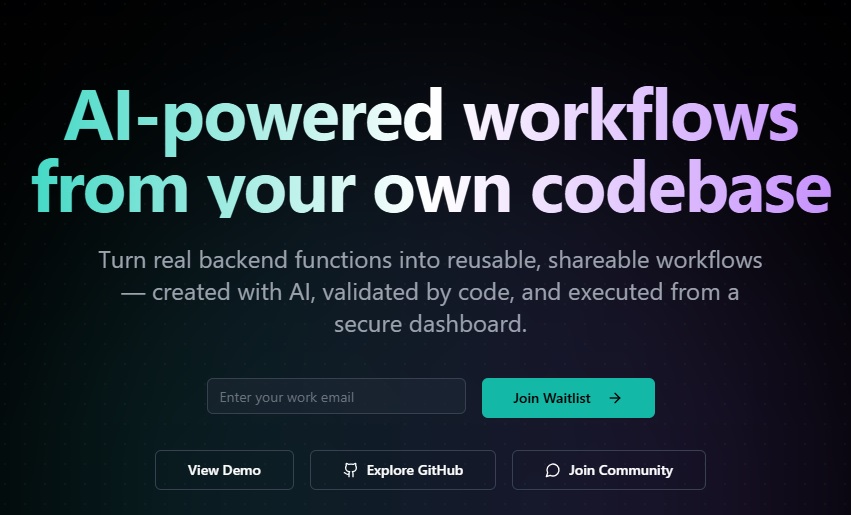When diving into the world of AI tools, it’s easy to get lost in the hype. Many platforms promise revolutionary features, but few truly deliver. That’s where usesashi.com, or more accurately, Sashi, appears to be carving out a unique and incredibly practical niche. From what I’ve gathered, Sashi isn’t just another AI assistant; it’s a platform designed to empower developers, operations teams, and product managers by turning complex backend functions into intuitive, AI-powered workflows and dashboards.
This focus on “Your internal tools. Built by your code. Powered by AI.” is what truly sets Sashi apart. It’s not about providing a generic AI; it’s about enabling businesses to leverage their existing codebases and transform them into intelligent, accessible applications without the need for extensive frontend development.
Let’s break down the core AI tools and features that make Sashi a fascinating player in the enterprise AI space:
The AI-Powered Engine: Turning Code into Workflows
Sashi’s primary strength lies in its ability to turn backend functions into AI-powered workflows and dashboards. This is a significant leap for internal tool development. Instead of building custom UIs from scratch for every internal process, Sashi enables you to:
- Register Code: You can register your existing backend functions – essentially, the logic and operations your systems already perform. This means you’re not reinventing the wheel but enhancing what you already have.
- Chain it: The AI then comes into play by allowing you to “chain” these registered code functions together to create complex workflows. This suggests an intelligent orchestration layer where the AI understands the dependencies and flow of your operations.
- Auto-generate UI – No Frontend Needed: This is the magic touch. Sashi’s AI is designed to automatically generate user interfaces (UIs) for these chained workflows and dashboards. For anyone who’s struggled with the time and resources required for frontend development for internal tools, this is a massive win. It democratizes the creation of powerful internal applications.
This capability is particularly beneficial for:
- Developers: They can focus on writing robust backend code without getting bogged down in UI design.
- Operations Teams: They gain immediate access to powerful tools to manage and monitor processes, even if those processes are complex backend operations.
- Product Managers: They can quickly prototype and deploy internal tools to test ideas and streamline internal operations, accelerating product development cycles.
Beyond Core Functionality: What Else Does Sashi Offer (or Promise)?
While the core concept of AI-powered workflow generation is compelling, here are some other implicit and explicit features that paint a broader picture of Sashi’s potential:
- Dashboards for Visibility: The mention of “dashboards” alongside workflows suggests that Sashi’s AI doesn’t just automate tasks but also provides visual insights into the performance and status of these operations. This is crucial for monitoring and making data-driven decisions.
- Intelligent Automation: By “powering” workflows with AI, Sashi implies more than just basic automation. It suggests an intelligent layer that might handle error detection, suggest optimizations, or adapt workflows based on real-time data and user interactions.
- Built for Developers, Ops, and PMs: This clear target audience indicates that the platform is designed with the specific needs and pain points of these roles in mind, aiming for a highly practical and user-centric approach to internal tool creation.
- Scalability and Efficiency: By reducing the need for custom frontend development, Sashi inherently promises increased efficiency and scalability in deploying internal tools. This frees up valuable engineering resources for more strategic initiatives.
My Takeaway: A Glimpse into the Future of Internal Tools
From a human perspective, Sashi feels like a truly innovative approach to solving a persistent problem in many organizations: the bottleneck of internal tool development. The promise of AI-powered embedded workflows that bypass the traditional frontend development cycle is incredibly appealing. It suggests a future where internal operations can be rapidly digitalized and optimized, allowing teams to be more agile and responsive.
While it’s currently on a waitlist (as per recent information), the concept behind usesashi.com is precisely what many businesses need to unlock the full potential of their backend infrastructure and existing code. It’s not about replacing human intelligence but augmenting it, allowing technical teams to focus on complex problem-solving while AI handles the often tedious task of building usable interfaces.
If Sashi delivers on its promise, it could genuinely transform how companies build and leverage their internal tools, making sophisticated backend capabilities accessible to a wider range of users within an organization. It’s a platform to watch for anyone serious about operational efficiency and smart automation.



 Facebook
Facebook
 LinkedIn
LinkedIn
 X
X
 Reddit
Reddit